
Every day life in Kandy is often an adventure — once you look out a window or step out the door, anything can happen! Our street is more like a little lane that leads down to a busier road. It is verdant and steep on one side and lined with houses on the other. It is a great place to see planted fruit trees — Mangos, Avocados, Jackfruit, Papayas, Bananas, Coconut Palms, Pomegranates and others — and also for an encounter with some of the local wildlife. Of course, sometimes you don’t even have to leave the house to experience the wildlife.
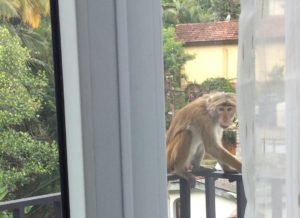
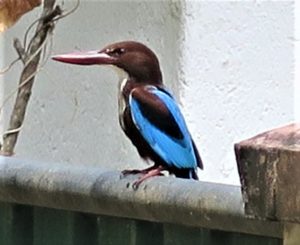
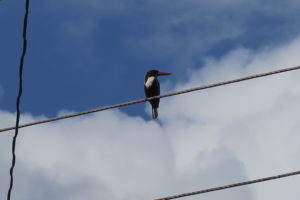
Almost everyday we see this White-Throated Kingfisher darting up and down our street. He follows us down to where we catch our Tuk Tuk, or soars past us when we make our way home back up the lane. But he never gets close enough or stays still long enough to let us get a good photograph — he seems to enjoy taunting us! Even worse, this shy bird lingers whenever we didn’t bring the camera, and then struts as if to pose! The blue on this bird is absolutely stunning, and it is breath-taking when it flashes in the sun, and we’ll keep trying to get picture that we are all happy with!
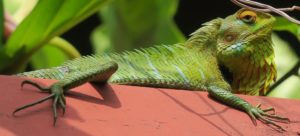
This neighbor was much easier to photograph! On our way home one hot afternoon, this Calotes lizard (“Crested Garden Lizard”) was sunning on top of a wall a couple of doors up the road from us.
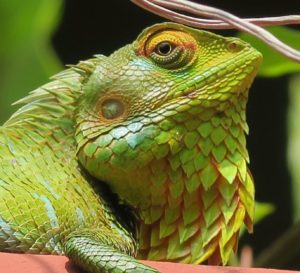
This cloisonne dragon can get big (up to about 2 ft. long) and this coloration — the stripes and the showy collar — identifies him as a male. His head will turn bright red during mating season (later this spring), particularly after a successful battle with rivals! Sometimes he is called a “Bloodsucker” Lizard (after his redneck) but that has nothing to do with what he eats.
Life (often) Outside the Fast Lane
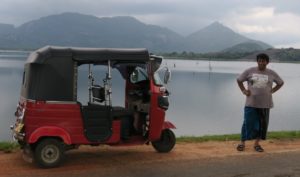

Where our lane meets the busy road is where we will often catch a Tuk Tuk into town or to work. When you need to get somewhere, at least for our purposes, the Tuk Tuk — sometimes called a Trishaw — is the way to go. These ubiquitous 3 wheelers can take you almost anywhere, often defying traffic and conventional ideas of lanes and going where full-sized cars, trucks and buses dare not go! Drivers decorate them according to their own tastes, and everyone is unique.
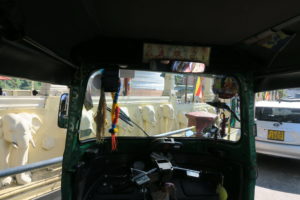
That said, there are definite trends among the more fashionable drivers. Pirates of the Caribbean is, inexplicably, a wildly popular motif here, along with Bob Marley and Native American images and Che Guevara and Captain America (sometimes sharing the same ride!), interspersed with cute babies, puppies, a mysterious man with a big beard, gurus, and scripted with all sorts of modern folk sayings that the newspapers here call Tuk Tuk Wisdom — deep sayings like, “Peace comes from within,” or “If You Bad, I’m Your Dad,” and “I am not cute — and I know it!” and worse. There’s nothing more bracing than a Tuk Tuk ride to work, enjoying the Tuk Tuk AC blowing in (as long as you aren’t stopped next to a bus or truck).
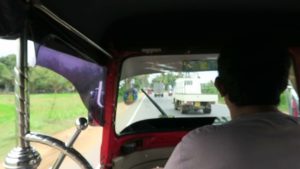

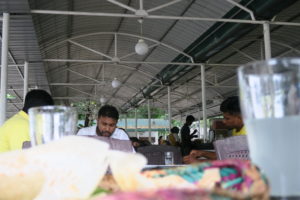
After you get to work at the beautiful campus of the University of Peradeniya, and put in a busy morning, it’s time for lunch! Right on campus — on the way when we walk home — is a restaurant called the Hela Bojun. It is one of a chain of inexpensive, socially-woke open-air restaurants — big covered food halls, really — found across the nation and run by the Ministry of Agriculture. There is a long counter separating the “dining area” from a line of nine or ten food stalls, and each food stall offers different rural specialties. Women manage each stall, and the whole concept behind the restaurants was to give rural women a chance to earn some money based on their skills — in this case cooking — and some experience managing their own enterprise. The food is vegetarian, fresh, and delicious!
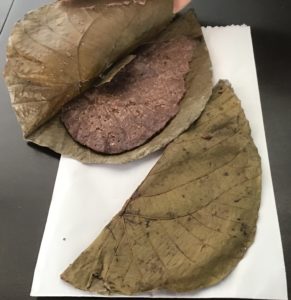
One tasty offering at the Hela Bojun is a very Sri Lankan delicacy called a halapa. It is a mixture of ground rice & red finger millet (Eleusine coccaran), grated coconut, jaggery sugar from Kithul (Caryota urens, Fish-tail Palm), all flavored with cinnamon & cardamom. This heady mixture is pressed & folded (taco-style) into a Kenda leaf & steamed. It is the perfect accompaniment with afternoon tea.
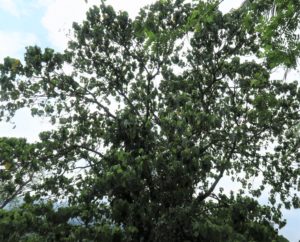
The Kenda leaf, which imparts a fresh leafy flavor, is from Macaranga peltata, a common shrub/tree of secondary successional growth. It’s in the Euphorbiaceae (spurge) family — known for having toxic properties. Other than Casaba, which is very well-processed, it is hard to recall another plant in that family with edible uses. Being a culinary cautionary, I‘ve gone online to find information on the hazards of Macaranga peltata, without much luck. No dire warnings, and instead found that the leaf has other food associated uses, such as natural “plates” and “wrappers” for jaggery sugar. Dave walks home past the Hela Bojun almost every day, and usually brings home a couple of halapas!
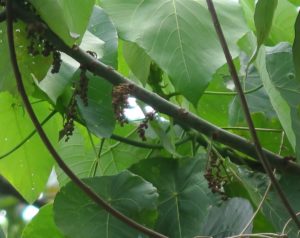
Besides the halapas, the HB almost always has someone selling Hoppers. Hoppers are a kind of very thin crispy-fried bread, where the Hopper-er will pour a thin layer of batter (fermented rice & coconut milk) into a frying pan that is shaped like a round shallow dish. The Hoppers come out like small bowls, with the edges thin and crisp and the base puffy, soft, and doughy. You fill them with almost anything (like eggs or cheese) but we like the spicy red chili pepper and onion paste or sambol called Lunu miris: it is so good!
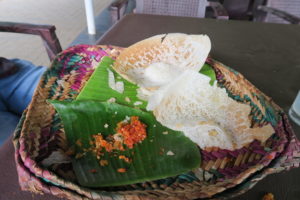
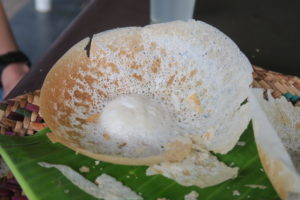
Following the Fulbright mandate to get out and explore the country, we’ve continued to try and use the weekends to visit some of the terrific cultural and historical sites around us. One weekend we took a bus out to Polonnaruwa, a city about four hours northeast of Kandy and the location of the UNESCO World Heritage site (just click here) also called Polonnaruwa.

It was the seat of the ancient kingdom of Polonnaruwa that peaked sometime in the 12th century, when the kings built a massive series of reservoirs and catchment basins, and canals that are still in use today. They built thousands of these tanks across the island to harvest the monsoon rains (the great hydraulic king Parakramabahu, d. 1186, is supposed to have said “not one of drop of water must flow into the ocean without serving humans first”) to last them through the dry season. And when is the dry season? Right now! And because it has been so dry lately — and because Sri Lanka depends on hydroelectric power — the government has begun rolling power cuts all across the island to conserve electricity. The power typically goes out right in the middle of working on this Blog!
This is the stupa at the Rankot Vihara, about 55 meters high and dating from about 1200. It is giant, and the 4th largest on the island. At almost all the royal cities the rulers built massive stupas to show their piety and their power, and they dominate the landscape. A stupa is typically an hemispherical artificial mound (usually covered with bricks and then often plastered with white lime) that covers a relic or objects associated with either the Buddha or, more often, Buddhist monks and nuns. Sri Lanka has some of the largest stupas in the world.

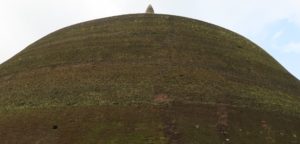
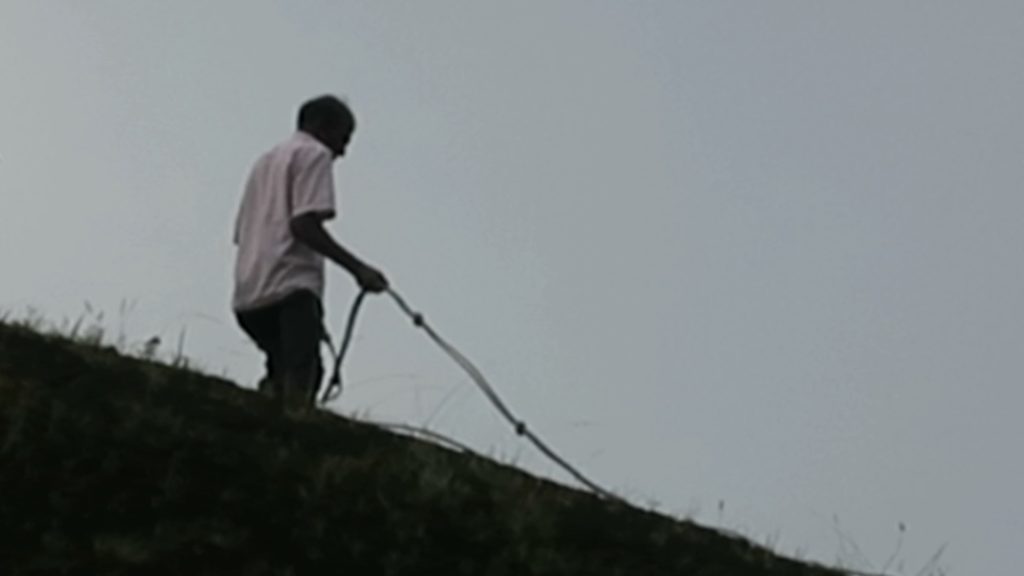
Along with visiting the stupas, people have been coming to Polonnaruwa for centuries to see the stunning Buddha sculptures carved out of the striped granite cliff at a place called Gal Vihara. These are three iconic 12th century images that show Buddha seated and meditating, Buddha standing thoughtfully, and a massive reclining Buddha. They are strikingly beautiful, with graceful forms and such wonderfully understated looks on their faces.

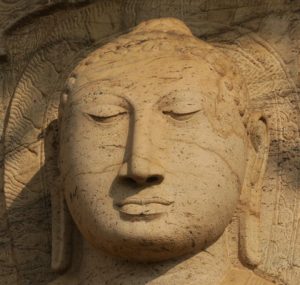
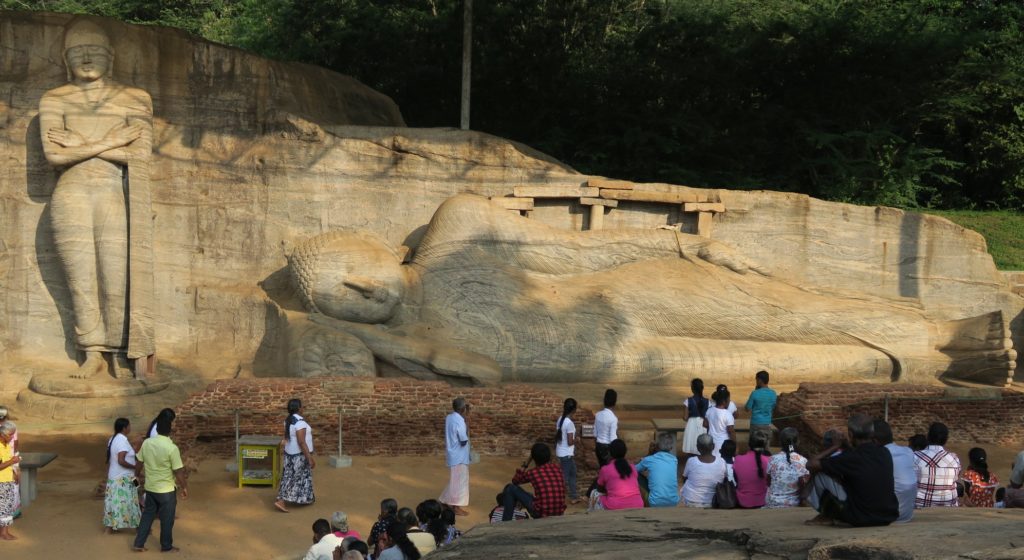

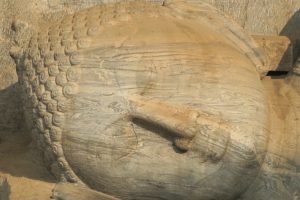
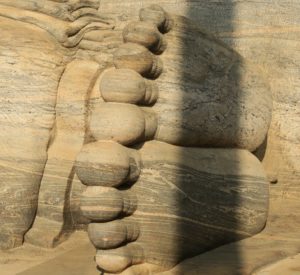
And finally, the famous and highly unusual Standing Buddha.


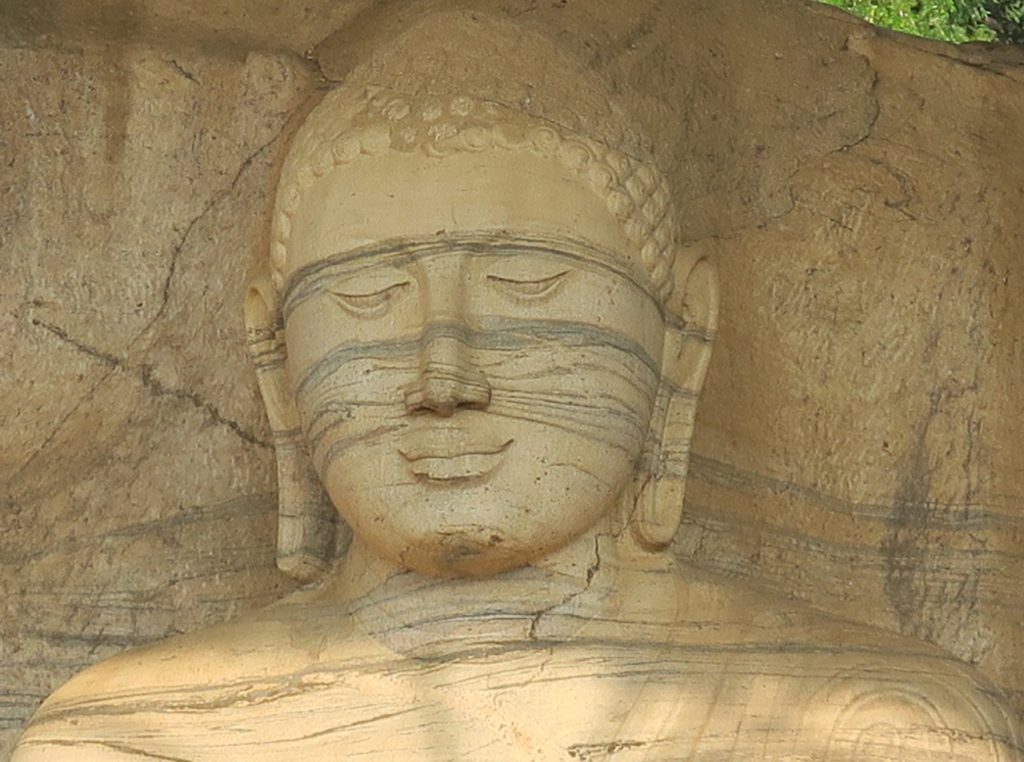
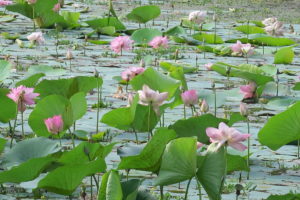
Right beside the sculptures at the Gal Vihara we found a lotus pond full of Sacred Lotus (Nelumbo nucifera) in bloom. The life-cycle of this plant — how it improbably seems to emerge from murky, even foul origins and then grow into a thing of pure beauty — embodies Buddhist, Hindu and Jain understandings of how a person can become something greater than they were. Often, in Asian religious painting, this flower is seen as a dais or a platform bearing a deity, or Buddha’s throne. Spiritual references aside, Nelumbo nucifera is an extraordinary plant for more than a few reasons. Some of you venerable ones may remember that it made the news when, in 1994, seed excavated from a dried lake bed in northeastern China — and dated to be 1,300 years old (give or take about 275 years!) — was successfully germinated! Perhaps this spurred fresh scientific examination of this plant. In asking how Nelumbo nucifera can arise from a muddy lake bottom and yet emerge from the water as a pure, clean and spotless creation, morphologists have discovered that the cuticle of the plant (which provides protection for most plants and prevents water loss) is covered in an extra layer of waxy crystalloids. These additional rough crystalloids on Nelumbo are so tiny and so fractile, that dirt and water molecules can’t adhere to them — like Teflon on steroids. That’s the secret of its immaculate purity!
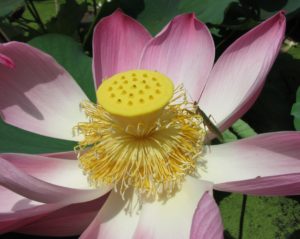
Another remarkable trait of the Sacred Lotus (and rarely seen in plants) is that it can regulate the temperature of its own flowers! The center of the flower has a cone-like receptacle which holds the seeds. This structure produces heat, and, depending on the ambient temperature, keeps the flower between 30-35 degrees C (86-95 degrees F). This is thought to make the flower more attractive to its insect pollinators (bees, thrips, flies and beetles). The petals even close up at night and form a warmed tent for beetles that dally for a nocturnal stay. So much more could be said about this plant (it’s culinary uses, its medicinal value, and more); for me, discovering the natural science behind its perfection even further enhances its sacredness.
One thing about Fulbright — they will keep you busy! We were so fortunate to get to travel to Kochi in Kerala state in south India in February and attend the Fulbright South and Central Asia Conference.
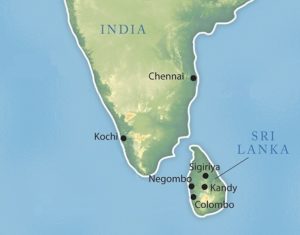
It was fun and informative to meet Fulbrighters from all over the region, and we learned so much from the presentations and conversations over the three days in India. It was amazing to us how much good and important work Fulbright scholars and researchers are doing in a territory stretching from Kyrgyzstan as far as, well, Sri Lanka! The event was organized wonderfully and efficiently, and at the end of the formal presentations there was an awesome talent show– it was really, truly impressive!

We also got the chance to explore Kochi a little bit. Kochi (Cochin in the old days) is an ancient seaport dubbed “the Pearl of the Arabian Sea,” with well over 2,000 years of history. It is the biggest city in Kerala state, and Kerala is in turn one the wealthiest and best-educated states in India. The town has a fine deep harbor but also sits at a confluence of rivers, streams, lakes, ponds and backwaters: there is water everywhere! A walk by the seaside downtown takes you past the Chinese Nets — a fishing technique said to have been introduced by Chinese sailors visiting Kerala back in the 1400s.
Kochi also has a very old and very small Jewish community, with the present synagogue dating back to the 1500s. the current Jewish community is quite small, but the Paradesi Synagogue is a popular spot with tourists.
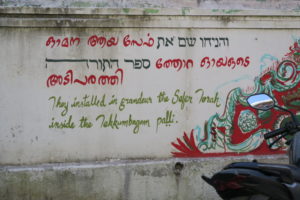

The area is famous for embroidery & stitchery, as well as perfume!
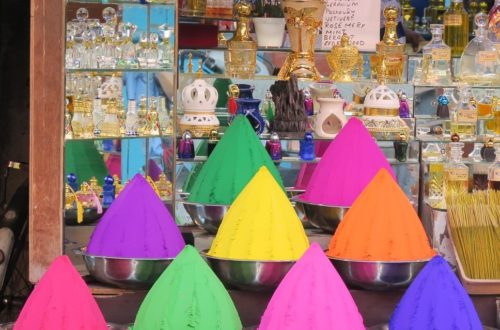
And of course there are always unexpected and gratuitous photos! First, here’s a “Schoolboat” dropping off Muslim schoolboys on their way to class early one day. We saw them one morning from our own boat while we were chugging our way to the conference.
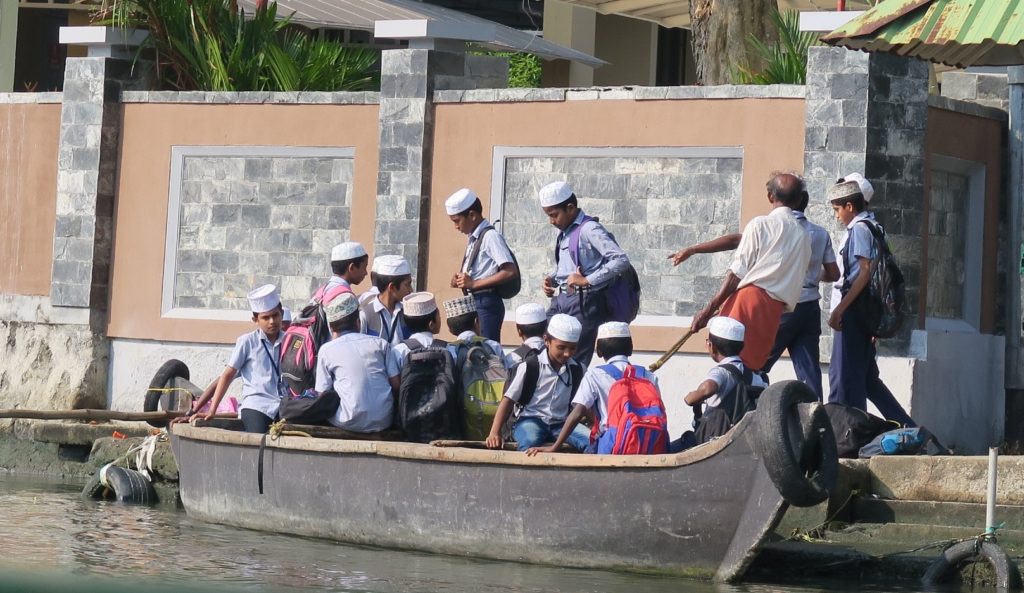
And here’s what we discovered when we arrived in Kochi’s ultra-modern International Airport — elephants!
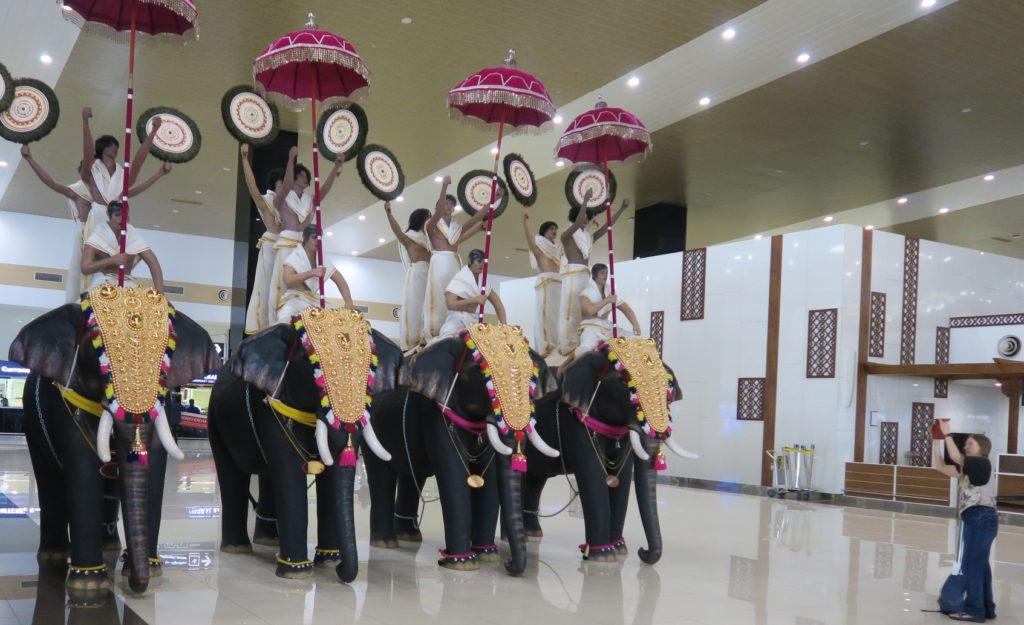
And finally, a New Year’s shout out to all our families, friends and fellow Fulbrighters! Saturday, April 13 marks the end of the present Sinhalese year, and Sunday, April 14 is the start of the new one! There are a few hours between the end of the old year and the start of the new one, and these few hours are inauspicious! Don’t do anything too serious in them — Sinhalese and Tamil Sri Lankans like to take it easy and visit temples then!

To everyone — Happy New Year and look for another post soon!

So much in this issue of your blog! I loved the tuktuks and
would love seeing the wide variety of tuktuk decor. The kingfisher and blood lizard were marvelous photos. It would be so exciting to find that lizard in my yard. Donuts and Lucifer would freak out! The Buddha sculpture s are beautiful and so impressive. But the elephant welcome at the airport has to be the best of all! You’ll never see that in the USA, the elephants would never make it through the security check point. Thanks so much, Dave and Dixie, for sharing all these wonderful things with us!
What a fantastic blog this is, I am enjoying it so much! I love to see all of the flora and fauna, the lotus is beautiful and the lizard is a magnificent work of art. Is his name, Y. Daddy perhaps? Sri Lanka seems to be a fascinating place. Keep up the wonderful blog, and tell us more about your adventures!
Thank you! You are spot on about the lizard nomenclature!
Thanks for sharing your adventures! Love seeing the local wildlife. I wonder what other birds you’ve been able to see/identify?
Hi Paul. We’ve seen Brahmaniny Kites, some sort of green parrots and today some beautiful yellow golden colored orioles, loras or bulbuls. There were 2 in fight today circling our rooftop flat, and not easy to get the details of. One thing for sure — they were really, really yellow and seemed to dance through the air.
Way cool!
Hi Dave and Dixie! I’m enjoying this blog so much. Your morning walk through all the plants and wildlife sounds heavenly. I hope the kingfisher decides to pose for you at a time when you can get the picture you want! Loved the Tuk Tuk ride, I could almost feel the breeze. And the food sounds amazing; are you bringing back any recipes? Thanks for sharing your travels so delightfully! Love, Karen P.S. Inki seems to be doing well and her appetite is good. She goes in for her abdominal imaging at noon tomorrow. In case this reply goes missing I’ll also send you an update via gmail. KA
Thanks for sharing your adventures with everyone. It’s wonderful that you’re able to explore their culture and natural beauty. Stanlee and Lynn
Thanks, Lynn. I know you and Stanlee would appreciate the birds!